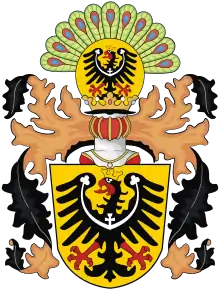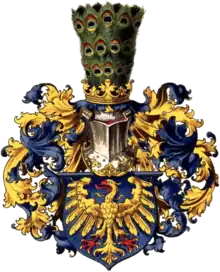Kłodzko
Kłodzko (pronounced Kwotsko [ˈkwɔt͡skɔ] (![]() listen); Czech: Kladsko; German: Glatz; Latin: Glacio) is a historic town in south-western Poland, in the region of Lower Silesia. It is situated in the centre of the Kłodzko Valley, on the Eastern Neisse river.
listen); Czech: Kladsko; German: Glatz; Latin: Glacio) is a historic town in south-western Poland, in the region of Lower Silesia. It is situated in the centre of the Kłodzko Valley, on the Eastern Neisse river.
Kłodzko | |
|---|---|
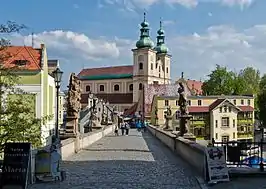 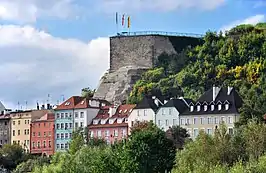 Gothic bridge and Baroque Church of Our Lady of the Rosary (top), Kłodzko Fortress overlooking the town (bottom) | |
 Flag | |
| Nickname(s): Luxembourg of the East, Little Prague | |
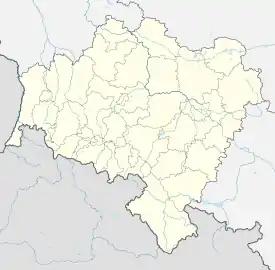 Kłodzko  Kłodzko | |
| Coordinates: 50°26′N 16°39′E | |
| Country | |
| Voivodeship | |
| County | Kłodzko County |
| Gmina | Kłodzko (urban gmina) |
| Established | 10th century |
| Town rights | 1233 |
| Government | |
| • Mayor | Michał Piszko |
| Area | |
| • Total | 25 km2 (10 sq mi) |
| Highest elevation | 370 m (1,210 ft) |
| Lowest elevation | 300 m (1,000 ft) |
| Population (2019-06-30[1]) | |
| • Total | 26,845 |
| • Density | 1,100/km2 (2,800/sq mi) |
| Time zone | UTC+1 (CET) |
| • Summer (DST) | UTC+2 (CEST) |
| Postal code | 57-300, 57-303, 57-304 |
| Area code(s) | +48 74 |
| Car plates | DKL |
| Website | klodzko.pl |
Kłodzko is the seat of Kłodzko County (and of the rural Gmina Kłodzko, although the town itself is a separate urban gmina), and is situated in Lower Silesian Voivodeship (from 1975–1998 it was in the former Wałbrzych Voivodeship). With 26,845 inhabitants (2019), Kłodzko is the main commercial centre as well as an important transport and tourist node for the area.
For its historical monuments it is sometimes referred to as "Little Prague" (Polish: Mała Praga, German: Klein-Prag).[2] Initially established as a settlement in the 10th century, it is one of the oldest towns in Poland, having been granted city rights in 1233. Culturally and traditionally a part of Bohemia, administratively it has been a part of Silesia since 1763.
History
Prehistory
The area of present-day Kłodzko has been populated at least since the 1st century BC. There are several archaeological sites both in and around the town that indicate that there must have been a settlement located on the ancient Amber Road that conducted extensive trade relations with the Roman Empire.
Medieval Bohemia and Poland
The earliest mention of the town itself is in the 12th-century Chronicle of Bohemians by Cosmas of Prague. He mentions the town of Cladzco as belonging to duke Slavník, father of Adalbert of Prague, in 981. Initially in Bohemia, together with the Kłodzko Land, it changed affiliation several times, passing between Poland and Bohemia[3] in a series of conflicts which in turn devastated the town completely by the beginning of the 12th century. In 1114 Bohemian Duke Soběslav I captured and burnt the town to the ground, but he rebuilt it shortly afterwards. He also rebuilt and strengthened the castle located on a high rock overlooking the town. After the Peace of Kłodzko of 1137, Duke Bolesław III Wrymouth of Poland ceded all claims to the Kłodzko Land to the Bohemian Duchy (later Kingdom).[3]
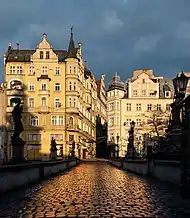
In 1241, Klodzko became the site of a Mongol raid during the Mongolian Invasion of Europe. However, King Wenceslaus I managed to rally his troops and drove the Mongols out, saving much of Bohemia from Mongolian conquest.[4][5] The town was granted German city rights under Magdeburg Law between 1253 and 1278, though the exact date is unknown. In 1278 it came under Polish rule again, as it was taken over by the Silesian duke Henry Probus who claimed entire Bohemian Kingdom after death of Ottokar II of Bohemia. In 1290 it was sold to the Dukes of Świdnica and then, in 1301, it was sold to the Dukes of Ziębice. However, in 1334, Duke Boleslav II sold the town back to the Kingdom of Bohemia. The same year Bohemian king John of Luxembourg, relocated the town, which led to a period of fast growth, bringing German settlers to the town. A city hall was built in 1341, and in the following year a brick factory was opened. From 1366, the town has been protected by a group of professional firemen. The town gained significant profits from its location on the ancient road from Bohemia to Poland through mountain passes in the Sudetes.
German Augustinian monks were invited to the city and, in 1376, most streets were paved with stone setts. The Augustinian abbey became one of the most important centres of culture in the region – for example, in 1399 one of the earliest texts in the Polish language, the St. Florian's Psalter (Psałterz Floriański), was written here. In 1390 a Gothic stone bridge over the Młynówka River (local branch of Eastern Neisse River) was built by the local lord.
County seat within Bohemia
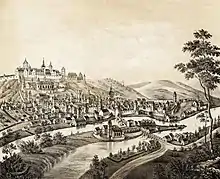
Kladsko developed rapidly until the start of the Hussite Wars in the 15th century. The wars left the town depopulated by plagues, partially burnt, and demolished by several consecutive floods. In 1459 whole Kłodzko Land was elevated by Bohemian king George of Poděbrady to the status of county – thus the city became a seat of Count (for most of time ruler of Bohemia itself) and local Diet – but still remained integral part of Bohemia as "outer region" (Czech: vnější kraj), and was not counted as part of Silesia. In 1472, the Polish prince Vladislaus Jagiellon stayed in the city before his coronation as King of Bohemia in Prague.[6]
In 1526 the Habsburgs succeeded after the Jagiellons as hereditary kings of Bohemia. Thus the County of Kladsko (hrabství Kladské, Grafschaft Glatz) became a part of the Habsburg Monarchy; the local counts retained their powers and Bohemian kings (i.e. Habsburg emperors) ruled this land as suzerains. It was not until the 16th century that the local economy began to recover from the previous wars. In 1540 the sewer system was built. In 1549 the remaining streets were paved and the city hall was refurbished. Most of the houses surrounding the town square were rebuilt in a pure Renaissance style.
In 1617 the first census was organised in the County of Glatz. The city itself had approximately 1,300 houses and over 7,000 inhabitants. However, two years after the census took place the Thirty Years' War started. Between 1619 and 1649 the fortress was besieged several times. Although the fortress was never captured, the city itself was largely destroyed. Over 900 out of 1,300 buildings were destroyed by fire and artillery and the population dropped by more than a half. After the war the Austrian authorities put an end to all local self-government, and the County of Glatz existed in name only. The city was gradually converted into a small garrison town attached to the ever-growing fortress.
Historical population
of Kłodzko
| 1620 | 6,500 | |
| 1734 | 4,400 | |
| 1807 | 4,549 | |
| 1809 | 4,887 | |
| 1816 | 5,510 | |
| 1825 | 6,187 | |
| 1834 | 6,644 | |
| 1840 | 7,654 | |
| 1843 | 7,777 | |
| 1849 | 8,222 | |
| 1858 | 13,052 | |
| 1871 | 11,545 | |
| 1880 | 13,701 | |
| 1885 | 13,588 | |
| 1894 | 13,501 | |
| 1900 | 15,015 | |
| 1905 | 16,052 | |
| 1910 | 17,121 | |
| 1912 | 17,284 | |
| 2003 | 30,100 |
Source:[7]
Kingdom of Prussia

The Kingdom of Prussia annexed Glatz during the 18th century Silesian Wars, although Austrian influence is still evident in the architecture and culture of the region. The construction of the fortress was continued and the town had to bear the costs of the fortress expansion. In 1760 the town was captured by Austrian forces in the Siege of Glatz, but was subsequently returned to Prussia.
Unlike most of Prussian Silesia, Glatz resisted French bombardment during the War of the Fourth Coalition.[8] During the 19th-century Polish national liberation fights, Polish publicist Włodzimierz Adolf Wolniewicz, Polish historian Wojciech Kętrzyński and Polish priest Augustyn Szamarzewski were imprisoned in the fortress.[9][10][11]
Germany
Glatz became part of the German Empire in 1871 during the Prussian-led unification of Germany. The restrictions in the city's growth were not withdrawn until 1877, after which the town began another period of rapid modernisation and expansion. Some of the forts were demolished, several new bridges were built, and new investments started to arrive in Glatz. The town was connected to the rest of Germany by a railway. In 1864 the gas works were built and in 1880 an electric plant was opened. The buildings along the main streets were rebuilt in Neo-Gothic and Neo-Renaissance style while the city walls with all their gates were demolished. In 1884–1885 was built a new synagogue on the Grünestraße [Green Street] designed by the Breslau architect Albert Grau.[12][13]
The end of the 19th century saw the Kłodzko Valley turned into one of the most popular tourist regions. Many hotels, sanatoria, and spa were opened to the public in the nearby towns of Bad Reinerz (Duszniki Zdrój), Habelschwerdt (Bystrzyca Kłodzka), Bad Altheide (Polanica Zdrój), and Bad Landeck (Lądek-Zdrój). The area of the former county became a popular place among the rich bourgeoisie of Breslau (Wrocław), Berlin, Vienna, and Kraków. In 1910 the city had 17,121 inhabitants: 13,629 Roman Catholics, 3,324 Protestants (mostly members of the Evangelical State Church of Prussia's older Provinces), and 150 Jews. During the November Pogrom (9 November 1938), colloquially euphemised as "Kristallnacht", the synagogue was destroyed by an arson attack of Nazis.[12] Most of the Jews emigrated and by 1939 there were only 25 of them left.
In September 1938 Glatz was severely damaged by "the flooding of the century", but the damage done was quickly repaired.
Czech claims
The Kłodzko Valley region on the Eastern Neisse River was the focus of several attempts to reincorporate the area into Czechoslovakia after the First World War even though it had a German majority. From the Czech perspective, Kłodzko and Kłodzko Land are culturally and traditionally a part of Bohemia, although the region has been a part of Lower Silesia since its conquest by the Kingdom of Prussia in 1763. These efforts to incorporate Kłodzko into Czechoslovakia would continue into the period after World War II.
- Proposals by the Czechoslovak Delegation on incorporating Kłodzko Land into Czechoslovakia during the Paris Peace Conference, 1919
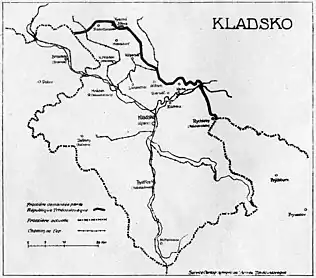 The maximalist variant
The maximalist variant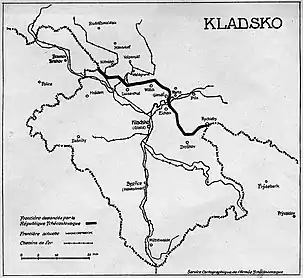 The intermediate variant
The intermediate variant The minimalist variant
The minimalist variant
World War II
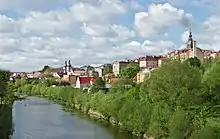
During World War II, the fortress was changed into a prison. At first it was administered by the Abwehr, but was soon taken over by the Gestapo. It was also used as a POW camp for officers of various nationalities. Beginning in 1944, the casemates housed the AEG arms factory evacuated from Łódź. The slave labourers were kept in the stronghold, which was turned into a subcamp of the Gross-Rosen concentration camp.
The town itself was not damaged by the war and was taken over by the Soviet Red Army without a major battle on 9 May 1945. However, all the bridges, except the Gothic stone bridge of 1390, were destroyed.
Poland
After the capitulation of Nazi Germany in 1945, the town was placed under Polish administration according to the Potsdam Conference. Since then it remains as part of Poland. The German inhabitants of the town were expelled. The town was repopulated by Poles, some of the whom were Polish refugees from regions east of the Curzon line, the Kresy, from where they had been displaced by Soviet authorities in accordance to new borders decided at Yalta Conference, while most came from war-devastated central Poland. In May 1945 Czechoslovakia tried to annex the area on behalf of Czech minority (living especially in the western part of the land, called "Czech Corner") and historical claims, but on pressure of Soviet union ceased military operations and Czech minority was expelled to Germany and Czechoslovakia.
In the 1950s and 1960s much of the town centre was damaged by landslides. It turned out that throughout the city's history, generations of Kłodzko's merchants had developed an extensive net of underground basements and tunnels. They were used for storage and, in times of trouble, as a safe shelter from artillery fire. With time the tunnels were forgotten, especially after the original German population was deported, and during the years after World War II many of them started to collapse, along with the houses above. Since the 1970s the tunnels were conserved and the destruction of the city was stopped. Another disaster happened in 1997, when the city was damaged by flooding even greater than that of 1938. However, the town quickly recovered.
On 28 June 1972 the Catholic parishes of Kłodzko were redeployed from the traditional Hradec Králové diocese (est. 1664; Ecclesiastical province of Bohemia) into the Archdiocese of Wrocław.[14]
Currently, Kłodzko is one of centres of culture, commerce and tourism in Lower Silesia. It is popular with German tourists interested in the city's history and among younger tourists for winter sports facilities of the region.

Climate
The climate is semicontinental although officially it is considered as oceanic (Köppen: Cfb), near of the humid continental (Dfb), considered as such by the isotherm of 0 °C. Located in western Poland where there is the clash of marine air masses and the interior of Siberia, they collide and generate a highly variable climate, although the patterns of the west are predominant.[15][16][17]
| Climate data for Kłodzko, elevation: 320 m, 1980-2012 normals | |||||||||||||
|---|---|---|---|---|---|---|---|---|---|---|---|---|---|
| Month | Jan | Feb | Mar | Apr | May | Jun | Jul | Aug | Sep | Oct | Nov | Dec | Year |
| Record high °C (°F) | 15.1 (59.2) |
17.2 (63.0) |
23.0 (73.4) |
25.4 (77.7) |
30.9 (87.6) |
32.0 (89.6) |
34.8 (94.6) |
35.1 (95.2) |
31.0 (87.8) |
25.0 (77.0) |
18.5 (65.3) |
18.0 (64.4) |
35.1 (95.2) |
| Average high °C (°F) | 0.6 (33.1) |
1.9 (35.4) |
6.7 (44.1) |
12.2 (54.0) |
17.7 (63.9) |
20.6 (69.1) |
22.4 (72.3) |
22.6 (72.7) |
18.0 (64.4) |
12.4 (54.3) |
5.8 (42.4) |
1.9 (35.4) |
11.9 (53.4) |
| Daily mean °C (°F) | −2.2 (28.0) |
−1.5 (29.3) |
2.8 (37.0) |
7.0 (44.6) |
12.0 (53.6) |
15.1 (59.2) |
16.8 (62.2) |
16.6 (61.9) |
12.9 (55.2) |
8.3 (46.9) |
3.0 (37.4) |
−0.7 (30.7) |
7.5 (45.5) |
| Average low °C (°F) | −4.9 (23.2) |
−4.8 (23.4) |
−1.1 (30.0) |
1.8 (35.2) |
6.2 (43.2) |
9.5 (49.1) |
11.1 (52.0) |
10.6 (51.1) |
7.7 (45.9) |
4.1 (39.4) |
0.2 (32.4) |
−3.3 (26.1) |
3.1 (37.6) |
| Record low °C (°F) | −30 (−22) |
−28.9 (−20.0) |
−20.3 (−4.5) |
−9.3 (15.3) |
−4.1 (24.6) |
−0.5 (31.1) |
1.0 (33.8) |
−0.8 (30.6) |
−3 (27) |
−11.6 (11.1) |
−19.3 (−2.7) |
−28.1 (−18.6) |
−30 (−22) |
| Average precipitation mm (inches) | 20.5 (0.81) |
20.1 (0.79) |
35.2 (1.39) |
33.8 (1.33) |
53.1 (2.09) |
81.7 (3.22) |
84.8 (3.34) |
56.8 (2.24) |
57.0 (2.24) |
35.3 (1.39) |
27.3 (1.07) |
27.8 (1.09) |
533.4 (21) |
| Average precipitation days | 10.1 | 9.6 | 11.2 | 10.0 | 11.6 | 12.6 | 12.7 | 10.2 | 11.3 | 9.8 | 10.6 | 11.6 | 131.3 |
| Source: climatebase.ru | |||||||||||||
| Climate data for Kłodzko (Szalejów Dolny), elevation: 356 m, 1961-1990 normals and extremes | |||||||||||||
|---|---|---|---|---|---|---|---|---|---|---|---|---|---|
| Month | Jan | Feb | Mar | Apr | May | Jun | Jul | Aug | Sep | Oct | Nov | Dec | Year |
| Record high °C (°F) | 10.4 (50.7) |
17.2 (63.0) |
23.0 (73.4) |
27.8 (82.0) |
31.7 (89.1) |
32.4 (90.3) |
34.8 (94.6) |
32.5 (90.5) |
30.7 (87.3) |
24.1 (75.4) |
17.4 (63.3) |
17.0 (62.6) |
34.8 (94.6) |
| Average high °C (°F) | 0.0 (32.0) |
1.9 (35.4) |
6.4 (43.5) |
12.2 (54.0) |
17.4 (63.3) |
20.5 (68.9) |
22.0 (71.6) |
21.9 (71.4) |
18.1 (64.6) |
12.9 (55.2) |
5.9 (42.6) |
1.7 (35.1) |
11.7 (53.1) |
| Daily mean °C (°F) | −2.7 (27.1) |
−1.3 (29.7) |
2.3 (36.1) |
6.9 (44.4) |
11.8 (53.2) |
14.9 (58.8) |
16.2 (61.2) |
15.8 (60.4) |
12.5 (54.5) |
8.2 (46.8) |
3.1 (37.6) |
−0.8 (30.6) |
7.2 (45.0) |
| Average low °C (°F) | −5.7 (21.7) |
−4.4 (24.1) |
−1.3 (29.7) |
2.1 (35.8) |
6.3 (43.3) |
9.4 (48.9) |
10.6 (51.1) |
10.4 (50.7) |
7.9 (46.2) |
4.5 (40.1) |
0.5 (32.9) |
−3.6 (25.5) |
3.1 (37.5) |
| Record low °C (°F) | −29.7 (−21.5) |
−27.5 (−17.5) |
−26.9 (−16.4) |
−8.2 (17.2) |
−3.3 (26.1) |
−0.2 (31.6) |
2.6 (36.7) |
1.1 (34.0) |
−4.1 (24.6) |
−7.6 (18.3) |
−19.3 (−2.7) |
−26.9 (−16.4) |
−29.7 (−21.5) |
| Average precipitation mm (inches) | 22 (0.9) |
24 (0.9) |
27 (1.1) |
35 (1.4) |
74 (2.9) |
91 (3.6) |
86 (3.4) |
88 (3.5) |
47 (1.9) |
36 (1.4) |
38 (1.5) |
26 (1.0) |
594 (23.5) |
| Average precipitation days (≥ 1.0 mm) | 5.9 | 5.9 | 7.3 | 7.3 | 10.3 | 10.9 | 10.4 | 9.9 | 6.7 | 6.2 | 7.8 | 7.3 | 95.9 |
| Source: NOAA[18] | |||||||||||||
Tourist attractions
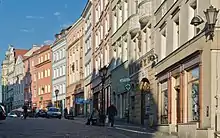
- Gothic bridge – often called a "Charles Bridge in miniature" due to its resemblance to one of the most notable historical monuments of Prague. The bridge survived a flood in 1997. The legend is that the bridge is made from eggs components.
- City tunnels – parts of the tunnels constructed under the city since the 13th century are open for the public
- The Church of Assumption – one of the most notable examples of Gothic architecture in Poland, constructed by the Order of Saint John in the 14th century
- Baroque Church of Our Lady of the Rosary and the Franciscan monastery
- The fortress – a unique stronghold on a high rock overlooking the city, first erected on this spot in the 9th century. During the reign of King Frederick the Great, it was one of the largest fortresses in Prussia.
- Town hall, built in 1890, but the older Gothic-Renaissance tower has been preserved
- Kłodzko Land Museum
- Marian Column – located at the market square, or the town square. It depicts the Blessed Virgin Mary and was constructed after a plague in 1625. This is a common sight in many other cities and towns that once belonged to the Habsburg Monarchy.
 Night view of the Gothic bridge
Night view of the Gothic bridge Interior of the Church of the Assumption
Interior of the Church of the Assumption Our Lady of the Rosary church
Our Lady of the Rosary church Night view of the town hall
Night view of the town hall Franciscan monastery
Franciscan monastery Baroque sculptures of Jesuit saints in the Old Town
Baroque sculptures of Jesuit saints in the Old Town
Education
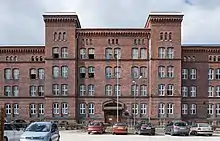
Educational establishments in Kłodzko include:
Notable residents
- Michael Friedrich von Althann (1680–1734), bishop and politician
- Gustav Adolf von Götzen (1866–1910), explorer
- Friedrich Wilhelm Hemprich (1796–1825), scientist
- Emma Ihrer (1857–1911), politician
- Łukasz Krawczuk (born 1989), male sprinter
- Annelies Kupper (1906–1987), opera singer
- Friedrich Wilhelm von Lindeiner-Wildau (1880–1963), Luftwaffe officer
- Gabriela Muskała (born 1969), actress
- Weronika Nowakowska (born 1986), female biathlete
- David Origanus (1558–1628), mathematician
- Ernest of Pardubice (1297–1364), the first Archbishop of Prague
- Johann Christoph Pezel (1639–1694), composer
- Mirosław Pękala (born 1961), former Polish international footballer
- Oswald Rathmann (1891–?), cyclist
- Otto Reche (1879–1966), scientist
- Friedrich Wilhelm Riemer (1774–1845), secretary of Johann Wolfgang von Goethe
- Friedrich Wilhelm Sander (1885–1938), engineer
- Albrecht Schubert (1886–1966), Wehrmacht general
- Renée Sintenis (1888–1965), artist
- Eduard Tauwitz (1812–1894), composer
- Sophie Charlotte Elisabeth Ursinus (1760–1836), serial killer
- Bogdan Zdrojewski (born 1957), politician
Surroundings
- Stołowe Mountains (Table Mountains) with Stołowe Mountains National Park
- Spa resorts in Polanica-Zdrój, Duszniki-Zdrój, Kudowa-Zdrój & Lądek-Zdrój
- Medieval town of Niemcza
- Cistercian monastery at Henryków
- Wojsławice Arboretum
- Gola Dzierżoniowska Castle
Twin towns – sister cities
See also
- List of floods in Kłodzko
- Kłodzko Land
- County of Kladsko (historical)
Notes
- "Population. Size and structure and vital statistics in Poland by territorial divison in 2019. As of 30th June". stat.gov.pl. Statistics Poland. 2019-10-15. Retrieved 2020-02-14.
- Jan Rzońca, Uzdrowiska ziemi kłodzkiej, "Ziemia Kłodzka" No. 223, 2013, p. 26 (in Polish)
- de Hartog, Leo. Genghis Khan: Conqueror of the World. Tauris Parke Paperbacks (January 17, 2004). p. 173. ISBN 978-1860649721
- Zimmermann, Wilhelm. A Popular History of Germany from the Earliest Period to the Present Day . Nabu Press (February 24, 2010). p. 1109. ISBN 978-1145783386
- Waldemar Brygier, Tomasz Dudziak, Ziemia Kłodzka. Przewodnik, Oficyna Wydawnicza Rewasz, Pruszków, 2010, p. 345 (in Polish)
- "Dawne Kłodzko". Historical Kłodzko. Archived from the original on 2005-01-25. Retrieved January 10, 2005.
- H. W. Koch. A History of Prussia. Barnes & Noble Books. New York. 1978. ISBN 0-88029-158-3, p. 161
- Paweł Wolniewicz, Włodzimierz Adolf Dołęga Wolniewicz, "Wieści Lubońskie", No. 1/2019, p. 27 (in Polish)
- Waldemar Brygier, Tomasz Dudziak, Ziemia Kłodzka. Przewodnik, Oficyna Wydawnicza Rewasz, Pruszków, 2010, p. 348 (in Polish)
- Marek Weiss. "Walczył z zaborcą jako kapłan, społecznik i działacz gospodarczy". Głos Wielkopolski (in Polish). Retrieved 6 March 2020.
- Grzybowski, Henryk (2 February 2016). "Nieoczekiwane wskrzeszenie kłodzkiej synagogi" [Unexpected revival of the Kłodzko synagogue]. Gazeta Prowincjonalna Ziemi Kłodzkiej (in Polish). Retrieved 4 November 2019.
- Łuczyński, Romuald Mariusz (2006). Chronologia dziejów Dolnego Śląska (in Polish). Wrocław: Oficyna Wydawnicza Atut – Wrocławskie Wydawnictwo Oświatowe. p. 448. ISBN 83-7432-095-8.
- Paulus VI, Constitutio Apostolica "Vratislaviensis - Berolinensis et aliarum", in: Acta Apostolicae Sedis, 64 (1972), n. 10, pp. 657seq.
- Szwed, Małgorzata (2018-02-26). "Variability of precipitation in Poland under climate change". Theoretical and Applied Climatology. 135 (3–4): 1003–1015. doi:10.1007/s00704-018-2408-6. ISSN 1434-4483.
- "Kłodzko climate: Average Temperature, weather by month, Kłodzko weather averages - Climate-Data.org". en.climate-data.org. Retrieved 2019-02-04.
- "Klodzko vs No. 6 Climate & Distance Between". www.klodzko.climatemps.com. Retrieved 2019-02-04.
- "Kłodzko (12520) - WMO Weather Station". NOAA. Retrieved January 4, 2019. Archived January 4, 2019, at the Wayback Machine.
- "Miasta partnerskie". klodzko.pl (in Polish). Kłodzko. Retrieved 2019-10-09.
External links
| Wikimedia Commons has media related to Kłodzko. |
- Municipal website
- Kłodzko commune (in Polish)
- Jewish Community in Kłodzko on Virtual Shtetl
- History of the Kladsko/Kłodzko land (in Czech)
- So-called "Czech Corner" in Kladsko/Kłodzko land (in Czech)


